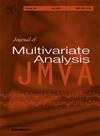稳健函数逆回归
IF 1.4
3区 数学
Q2 STATISTICS & PROBABILITY
引用次数: 0
摘要
功能充分降维(FSDR)是回归设置中监督降维的一种流行方法,因为它允许将功能预测因子降维到较低维的子空间而不会丢失信息。然而,大多数现有的FSDR方法容易受到重尾性或异常值的影响,这在许多实际应用中很常见。为了解决这一限制,我们提出了一种鲁棒的FSDR方法,该方法利用功能性成对空间符号(PASS)算子。这种方法既适用于完全观测到的功能数据,也适用于稀疏观测到的纵向数据。我们的方法通过考虑数据的空间信息并为不容易出现异常值的观测值分配更大的权重,为FSDR提供了一种更稳健的方法。我们还提供了估计器的收敛率分析,证明我们的方法产生了一致的降维方向估计。通过大量的仿真和实际数据分析,证明了该方法的有效性。我们的方法在鲁棒性和准确性方面优于现有的方法,使其成为分析各种应用程序中的功能数据的有价值的工具。本文章由计算机程序翻译,如有差异,请以英文原文为准。
Robust functional inverse regression
Functional sufficient dimension reduction (FSDR) is a popular approach for supervised dimensionality reduction in regression settings, as it allows for the reduction of functional predictors to a lower-dimensional subspace without loss of information. However, most existing FSDR methods are vulnerable to heavy-tailedness or outliers, which are common in many real-world applications. To address this limitation, we propose a robust FSDR method that utilizes a functional pairwise spatial sign (PASS) operator. This approach is suitable for both completely observed functional data and sparsely observed longitudinal data. Our method provides a more robust approach to FSDR, by taking into account the spatial information of the data and assigning greater weights to the less outlier-prone observations. We also provide a convergence rate analysis of the estimator, demonstrating that our method yields a consistent estimate of the dimension reduction directions. The effectiveness of our proposed method is demonstrated through extensive simulations and real data analysis. Our method outperforms existing methods in terms of robustness and accuracy, making it a valuable tool for analyzing functional data across various applications.
求助全文
通过发布文献求助,成功后即可免费获取论文全文。
去求助
来源期刊

Journal of Multivariate Analysis
数学-统计学与概率论
CiteScore
2.40
自引率
25.00%
发文量
108
审稿时长
74 days
期刊介绍:
Founded in 1971, the Journal of Multivariate Analysis (JMVA) is the central venue for the publication of new, relevant methodology and particularly innovative applications pertaining to the analysis and interpretation of multidimensional data.
The journal welcomes contributions to all aspects of multivariate data analysis and modeling, including cluster analysis, discriminant analysis, factor analysis, and multidimensional continuous or discrete distribution theory. Topics of current interest include, but are not limited to, inferential aspects of
Copula modeling
Functional data analysis
Graphical modeling
High-dimensional data analysis
Image analysis
Multivariate extreme-value theory
Sparse modeling
Spatial statistics.
 求助内容:
求助内容: 应助结果提醒方式:
应助结果提醒方式:


